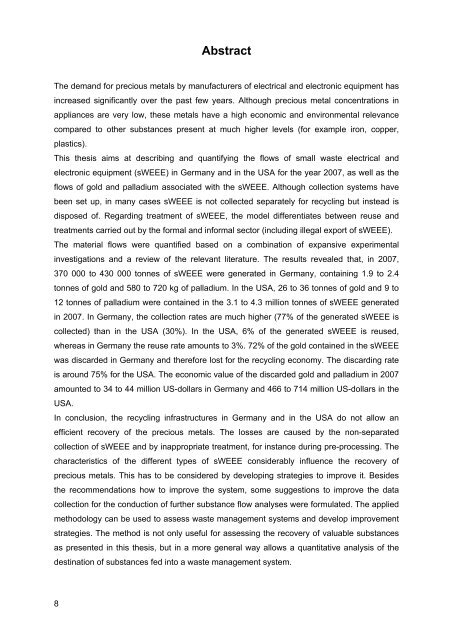SUbstance flow analysis of the recycling of small waste electrical ...
SUbstance flow analysis of the recycling of small waste electrical ...
SUbstance flow analysis of the recycling of small waste electrical ...
Create successful ePaper yourself
Turn your PDF publications into a flip-book with our unique Google optimized e-Paper software.
Abstract<br />
The demand for precious metals by manufacturers <strong>of</strong> <strong>electrical</strong> and electronic equipment has<br />
increased significantly over <strong>the</strong> past few years. Although precious metal concentrations in<br />
appliances are very low, <strong>the</strong>se metals have a high economic and environmental relevance<br />
compared to o<strong>the</strong>r substances present at much higher levels (for example iron, copper,<br />
plastics).<br />
This <strong>the</strong>sis aims at describing and quantifying <strong>the</strong> <strong>flow</strong>s <strong>of</strong> <strong>small</strong> <strong>waste</strong> <strong>electrical</strong> and<br />
electronic equipment (sWEEE) in Germany and in <strong>the</strong> USA for <strong>the</strong> year 2007, as well as <strong>the</strong><br />
<strong>flow</strong>s <strong>of</strong> gold and palladium associated with <strong>the</strong> sWEEE. Although collection systems have<br />
been set up, in many cases sWEEE is not collected separately for <strong>recycling</strong> but instead is<br />
disposed <strong>of</strong>. Regarding treatment <strong>of</strong> sWEEE, <strong>the</strong> model differentiates between reuse and<br />
treatments carried out by <strong>the</strong> formal and informal sector (including illegal export <strong>of</strong> sWEEE).<br />
The material <strong>flow</strong>s were quantified based on a combination <strong>of</strong> expansive experimental<br />
investigations and a review <strong>of</strong> <strong>the</strong> relevant literature. The results revealed that, in 2007,<br />
370 000 to 430 000 tonnes <strong>of</strong> sWEEE were generated in Germany, containing 1.9 to 2.4<br />
tonnes <strong>of</strong> gold and 580 to 720 kg <strong>of</strong> palladium. In <strong>the</strong> USA, 26 to 36 tonnes <strong>of</strong> gold and 9 to<br />
12 tonnes <strong>of</strong> palladium were contained in <strong>the</strong> 3.1 to 4.3 million tonnes <strong>of</strong> sWEEE generated<br />
in 2007. In Germany, <strong>the</strong> collection rates are much higher (77% <strong>of</strong> <strong>the</strong> generated sWEEE is<br />
collected) than in <strong>the</strong> USA (30%). In <strong>the</strong> USA, 6% <strong>of</strong> <strong>the</strong> generated sWEEE is reused,<br />
whereas in Germany <strong>the</strong> reuse rate amounts to 3%. 72% <strong>of</strong> <strong>the</strong> gold contained in <strong>the</strong> sWEEE<br />
was discarded in Germany and <strong>the</strong>refore lost for <strong>the</strong> <strong>recycling</strong> economy. The discarding rate<br />
is around 75% for <strong>the</strong> USA. The economic value <strong>of</strong> <strong>the</strong> discarded gold and palladium in 2007<br />
amounted to 34 to 44 million US-dollars in Germany and 466 to 714 million US-dollars in <strong>the</strong><br />
USA.<br />
In conclusion, <strong>the</strong> <strong>recycling</strong> infrastructures in Germany and in <strong>the</strong> USA do not allow an<br />
efficient recovery <strong>of</strong> <strong>the</strong> precious metals. The losses are caused by <strong>the</strong> non-separated<br />
collection <strong>of</strong> sWEEE and by inappropriate treatment, for instance during pre-processing. The<br />
characteristics <strong>of</strong> <strong>the</strong> different types <strong>of</strong> sWEEE considerably influence <strong>the</strong> recovery <strong>of</strong><br />
precious metals. This has to be considered by developing strategies to improve it. Besides<br />
<strong>the</strong> recommendations how to improve <strong>the</strong> system, some suggestions to improve <strong>the</strong> data<br />
collection for <strong>the</strong> conduction <strong>of</strong> fur<strong>the</strong>r substance <strong>flow</strong> analyses were formulated. The applied<br />
methodology can be used to assess <strong>waste</strong> management systems and develop improvement<br />
strategies. The method is not only useful for assessing <strong>the</strong> recovery <strong>of</strong> valuable substances<br />
as presented in this <strong>the</strong>sis, but in a more general way allows a quantitative <strong>analysis</strong> <strong>of</strong> <strong>the</strong><br />
destination <strong>of</strong> substances fed into a <strong>waste</strong> management system.<br />
8

















